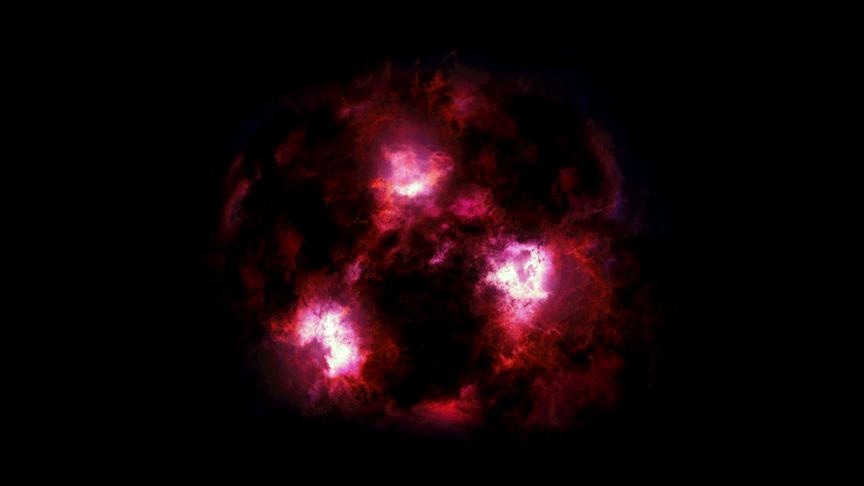Oct 23 2019
The accidental discovery of faint traces of an enormous galaxy, dating from the early universe, which was never observed before has been reported by a team of astronomers from the University of Massachusetts Amherst, including assistant professor Kate Whitaker who is an expert in early galaxy formation and evolution.
 An artist’s impression of what a massive galaxy in the early universe might look like. (Image credit: Courtesy of James Josephides, Swinburne Astronomy Productions; Christina Williams, University of Arizona; and Ivo Labbé, Swinburne University)
An artist’s impression of what a massive galaxy in the early universe might look like. (Image credit: Courtesy of James Josephides, Swinburne Astronomy Productions; Christina Williams, University of Arizona; and Ivo Labbé, Swinburne University)
The researchers, led by postdoctoral fellow Christina Williams from the University of Arizona, compared the observation to capturing images of footprints of the mythical Yeti, and said such monster galaxies were once regarded as folklore by the scientific community as there was no evidence for their existence, to date.
According to the authors, the discovery offers a new understanding of the first evolving steps of some of the largest galaxies in the universe. Details of the study have been reported in the current issue of the Astrophysical Journal.
These otherwise hidden galaxies are truly intriguing; it makes you wonder if this is just the tip of the iceberg, with a whole new type of galaxy population just waiting to be discovered.
Kate Whitaker, Assistant Professor, University of Massachusetts Amherst
For this study, the astronomers used the Atacama Large Millimeter Array (ALMA)––a collection of 66 radio telescopes situated in the high mountains of Chile. Williams observed a faint blob of light in new observations with extremely sensitive detection limits.
It was very mysterious, but the light seemed not to be linked to any known galaxy at all. When I saw this galaxy was invisible at any other wavelength, I got really excited, because it meant that it was probably really far away and hidden by clouds of dust.
Christina Williams, Postdoctoral Fellow, University of Arizona
As per the predictions of the team, the signal came from so far a distance that it took 12.5 billion years to reach Earth, when the universe was still very young. They propose that the emission detected is due to the warm glow of dust particles—which effectively conceal all light—heated by stars forming deep within a young galaxy.
We figured out that the galaxy is actually a massive monster galaxy with as many stars as our Milky Way but brimming with activity, forming new stars at 100 times the rate of our own galaxy.
Ivo Labbé, Study Co-Author, Swinburne University of Technology
According to Whitaker and Williams, both UMass Amherst alumni, as well as their collaborators, the finding could offer the answer to a long-standing question in astronomy.
Some of the largest galaxies in the young universe seem to have enlarged and matured very fast, which is contrary to the theoretical predictions. What is more mysterious is that these mature galaxies seem to emerge out of nowhere when the universe was relatively young, only 10% percent of its present age, they indicate.
Moreover, astronomers have never observed them while they form, noted Williams. Although smaller galaxies have been observed in the early universe using the Hubble space telescope, they are not expanding fast enough.
Although monster galaxies have been sighted even earlier, those sightings have been extremely rare for a satisfactory explanation of what was happening. Now, she says, “Our hidden monster galaxy has precisely the right ingredients to be that missing link, because they are probably a lot more common.”
According to the astronomers, the open question at present is exactly how many such monster galaxies exist. The present study was performed in a very small part of the sky, with a size of less than 1/100th of that of the full moon. The implication could be that spotting “Yeti footprints” in a small strip of wilderness means either it was found by chance, or they are cloaked but lurking all over the space.
According to Williams, “Right now we are eager for the James Webb Space Telescope (JWST) to take a look at these things,” referring to a groundbreaking new telescope planned to be launched in March 2021. “JWST will be able to look through the dust veil so we can learn how big these galaxies really are and how fast they are growing, to better understand why models fail in explaining them,” she added.